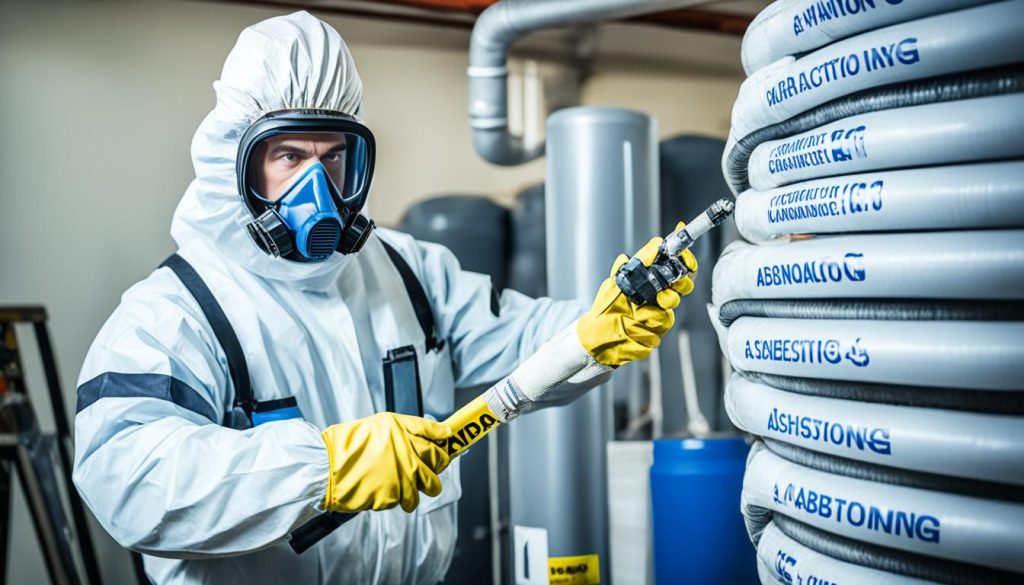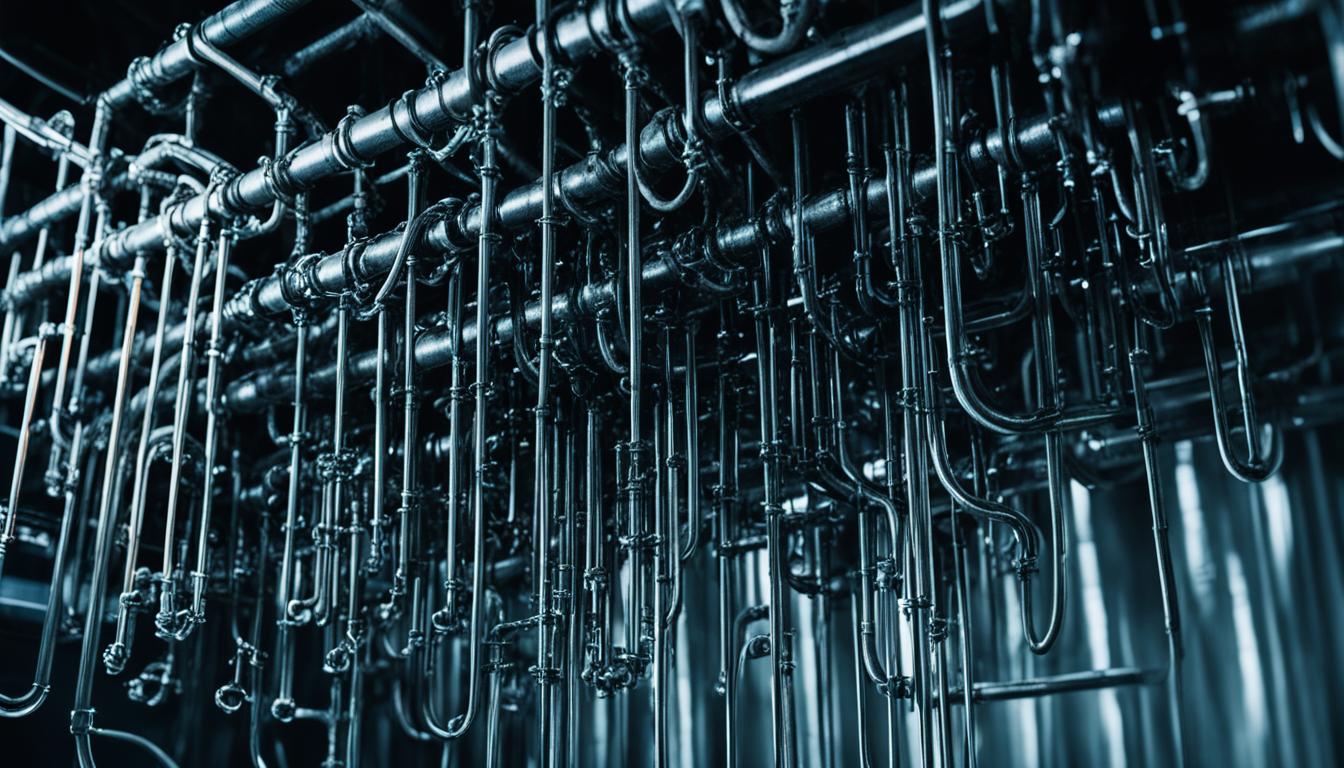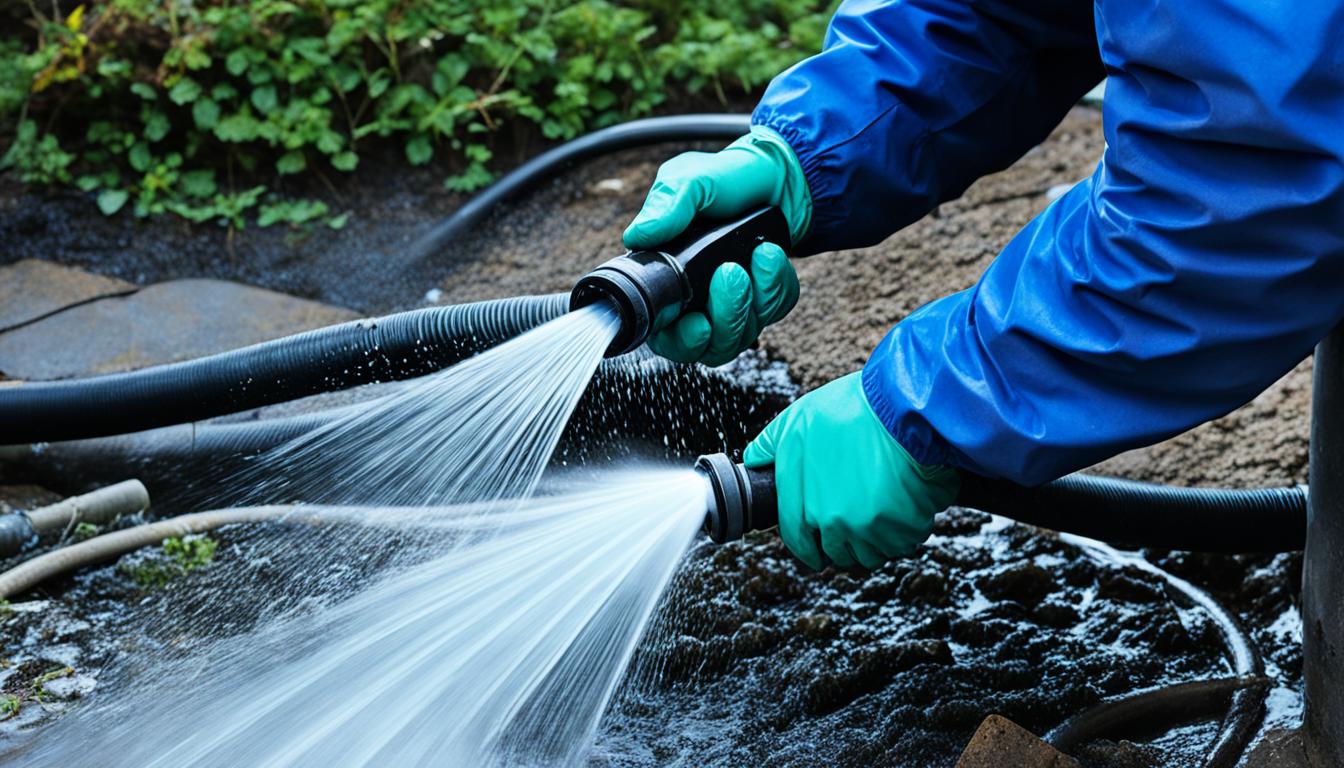Asbestos Wrapped Pipes: Safe Management Tips
Did you know that asbestos exposure can lead to serious health risks, including lung cancer, mesothelioma, and asbestosis? Despite its prohibition in many countries, asbestos-containing materials (ACMs) can still be found in buried cement pipes, posing a potential threat to workers who come in contact with them. To ensure the safety of workers and prevent the release of asbestos fibers, it is crucial to implement proper management practices when dealing with asbestos wrapped pipes.
Key Takeaways:
- Exposure to asbestos in wrapped pipes can cause serious health risks, including lung cancer, mesothelioma, and asbestosis.
- Asbestos-containing materials (ACMs) can still be found in buried cement pipes, even though the use of asbestos is prohibited in many countries.
- Proper risk assessment and safe work practices should be implemented to prevent the release of asbestos fibers.
- Workers should be trained and equipped with the necessary personal protective equipment (PPE) to minimize the risk of asbestos exposure.
- If significant amounts of ACMs are identified or the material is damaged, it is recommended to hire a specialist contractor for removal and abatement.
Understanding the Risks of Asbestos Fibres
Breathing in asbestos fibres can have severe consequences for your health. Exposure to asbestos is associated with various illnesses, including lung cancer, mesothelioma, and asbestosis. The World Health Organization estimates that asbestos exposure leads to over 100,000 premature deaths globally each year.
Asbestos fibres are incredibly small and can easily be inhaled into the lungs. Once inhaled, these fibres can become lodged in the lung tissue and cause long-term damage. Unlike other substances, asbestos fibres do not break down easily, leading to chronic inflammation and scarring of the lungs.
It is crucial to manage asbestos-containing materials properly to minimize the risk of exposure and protect your health. This involves taking appropriate precautions when handling and working with asbestos, as well as implementing effective control measures in areas where asbestos is present.
Risks of Asbestos Fibres
- Increased risk of lung cancer
- Development of mesothelioma, a rare and aggressive cancer that affects the lining of the lungs, abdomen, or heart
- Asbestosis, a chronic lung disease characterized by scarring and fibrosis of the lung tissue
- Other asbestos-related diseases, including pleural plaques and pleural thickening
Asbestos fibres pose a significant threat to human health, and it is crucial to take the necessary measures to prevent exposure. By understanding the risks associated with asbestos fibres and implementing proper safety practices, you can protect yourself and others from the potential harm they can cause.
Identifying Asbestos Wrapped Pipes
Asbestos wrapped pipes are commonly found in older buildings. These pipes can pose a significant risk to the health and safety of workers and occupants. It is essential to identify these asbestos-wrapped pipes accurately to implement the necessary safety measures and prevent asbestos exposure.
One way to identify asbestos wrapped pipes is through their appearance. Asbestos insulation typically appears as a white, fibrous material that may be frayed or deteriorated. The pipes may also be wrapped in a cloth-like material or covered with a plaster-like substance. If you come across pipes that have these characteristics, it is crucial to treat them as potential asbestos-containing materials (ACMs) and take appropriate precautions.
However, visual inspection alone may not always be sufficient for accurate identification. In such cases, testing the material is recommended to confirm the presence of asbestos. Samples can be taken by a qualified professional and sent to a certified laboratory for analysis. Testing can determine the percentage of asbestos in the pipes and provide certainty regarding the need for asbestos precautions.
Identifying ACMs in cement pipes:
In addition to identifying asbestos wrapped pipes, it is essential to recognize other common ACMs, such as cement pipes. Cement pipes were commonly used in plumbing systems, and they may contain asbestos as well. Recognizing cement pipes that may have asbestos insulation is crucial for appropriate risk assessment and management.
| Pipe Type | Identification |
|---|---|
| Asbestos Wrapped Pipes | Appearance: White, fibrous material May be frayed or deteriorated Wrapped in cloth-like material or covered with plaster-like substance |
| Cement Pipes | Appearance: Solid, gray-colored material May show signs of wear and age Presence of asbestos may need to be confirmed through testing |
Proper training and education play a crucial role in identifying ACMs, including asbestos wrapped pipes and cement pipes. Workers should receive training on recognizing the physical characteristics of these materials to minimize the risk of exposure. They should also understand the importance of treating these materials as potentially hazardous and taking appropriate safety measures.
By accurately identifying asbestos wrapped pipes and other ACMs, we can take the necessary steps to protect workers and occupants from the dangers of asbestos exposure.
Safe Handling and Maintenance of Asbestos Wrapped Pipes
When it comes to working with asbestos wrapped pipes, safety should be the top priority. Following proper handling and maintenance practices is essential in preventing the release of asbestos fibers and ensuring the well-being of workers. Let’s explore some key guidelines to ensure safe asbestos pipe maintenance.
1. Conduct a Comprehensive Risk Assessment
Before commencing any work on asbestos wrapped pipes, it is crucial to conduct a thorough risk assessment. This assessment helps identify potential hazards and develop effective control measures to mitigate the risk of asbestos fiber release. By assessing the condition of the pipes and the surrounding environment, you can determine the appropriate safety measures to implement.
2. Adhere to Safe Work Practices
Implementing safe work practices is paramount in minimizing asbestos fiber release during pipe maintenance. One crucial practice is using non-powered hand-held tools for cutting instead of methods that generate dust or create vibrations that can dislodge fibers. Additionally, wetting the pipes before any cutting or removal activities can minimize the release of fibers into the air.
3. Provide Adequate Personal Protective Equipment (PPE)
Supplying workers with appropriate personal protective equipment is essential for their safety. When handling asbestos wrapped pipes, workers should wear FFP3-rated face masks, rubber gloves, disposable hooded coveralls, and safety boots. These protective measures help prevent the inhalation or skin contact with asbestos fibers, reducing the risk of exposure.
4. Follow Proper Waste Disposal Procedures
Proper waste disposal is crucial in preventing further exposure to asbestos fibers. All waste materials, including debris and contaminated clothing, should be disposed of in accordance with local regulations for hazardous materials. Ensuring the proper containment and disposal of asbestos-contaminated materials helps protect both workers and the environment.
| Safe Handling and Maintenance Practices | Benefits |
|---|---|
| Conducting a risk assessment | Identifies potential hazards and allows for effective control measures |
| Implementing safe work practices | Minimizes release of asbestos fibers during maintenance activities |
| Providing adequate PPE | Reduces the risk of exposure to asbestos fibers |
| Following proper waste disposal procedures | Prevents further exposure to asbestos fibers |
Pipe Removal and Abatement
If significant amounts of ACMs have been identified and the material is damaged, it is recommended to hire a specialist contractor for the asbestos pipe removal and abatement process. This ensures that the work is done safely and in compliance with regulations. Professional removal services have the expertise and equipment to handle asbestos pipes effectively, minimizing the risk of fiber release and exposure.
During the removal process, the contractor will follow established protocols to protect workers and occupants of the building. They will take precautions to contain the area and prevent the spread of asbestos fibers. This may include sealing off the work area, using negative air pressure systems, and using specialized tools and techniques to minimize fiber release.
Once the asbestos pipes have been removed, careful consideration must be given to their proper disposal. Asbestos is classified as hazardous waste, and it should be treated and disposed of accordingly. The removed pipes should be sealed and transported to licensed facilities for hazardous waste disposal. This ensures that the asbestos-containing materials are securely contained and do not pose a risk to the environment or public health.
Proper decontamination procedures should also be followed after the removal and disposal of asbestos pipes. This includes cleaning the work area, equipment, and surfaces that may have come into contact with asbestos fibers. Thorough decontamination is essential to prevent any potential residual contamination and ensure the safety of workers and building occupants.
To ensure a successful and safe asbestos pipe removal and abatement process, it is crucial that all workers involved are properly trained on safe removal practices. They should be educated about the hazards of asbestos exposure and equipped with the necessary personal protective equipment (PPE) to protect themselves and others from fiber inhalation.
| Benefits of Professional Removal Services | Why Proper Disposal is Important |
|---|---|
|
|
Encapsulation and Management Techniques
In some cases, encapsulation may be a viable option to manage asbestos wrapped pipes. This involves the application of sealants or protective wraps to contain the asbestos fibres and prevent their release. Encapsulation should only be done by trained professionals using approved materials and methods. Regular inspections and maintenance should be conducted to ensure the encapsulation remains intact and effective.
To encapsulate asbestos wrapped pipes, there are several methods that can be used:
- Coating: Applying a specialised coating that forms a protective barrier over the asbestos material, preventing the fibres from becoming airborne.
- Enclosing: Building an airtight enclosure or housing around the asbestos wrapped pipes, effectively containing the fibres and minimizing the risk of exposure.
- Wrapping: Using approved wrapping materials, such as fabric or tape, to securely cover the asbestos wrapped pipes and prevent the release of fibres.
| Advantages of Encapsulation | Disadvantages of Encapsulation |
|---|---|
|
|
It is crucial to note that encapsulation should always be carried out in accordance with local regulations and guidelines. Additionally, periodic monitoring and assessment should be conducted to ensure the effectiveness of the encapsulation and the management of asbestos wrapped pipes.
Training and Education for Workers
All workers who may come into contact with asbestos wrapped pipes should receive proper training and education. It is crucial for them to understand the hazards associated with asbestos exposure, the importance of safe working methods, and the proper use of personal protective equipment (PPE). Additionally, workers should be trained on the correct procedures for cleaning and disposing of asbestos-contaminated materials.
Continuous education and refresher training programs should be implemented to ensure that workers stay up-to-date with the latest safety practices and regulations. Ongoing training helps reinforce the awareness of asbestos risks and reinforces the importance of adhering to safe work practices.
By providing comprehensive asbestos training to workers, employers can create a safer work environment and minimize the potential health risks associated with asbestos exposure. Workers who are well-informed and educated about asbestos hazards are more likely to follow proper protocols, reducing the likelihood of accidents and injuries.
Benefits of Worker Education on Asbestos
- Increased awareness of asbestos-related health risks
- Improved understanding of safe work practices
- Enhanced ability to identify and handle asbestos-containing materials
- Promotion of a safety culture within the workplace
- Reduced risk of asbestos exposure and related illnesses
- Compliance with legal requirements and regulations
Employers should prioritize the health and safety of their workers by providing adequate asbestos training and education. By investing in worker education, businesses can protect their employees and minimize the potential liability associated with asbestos-related health issues.
Training Program Outline
A comprehensive asbestos training program should cover the following topics:
| Training Topics | Description |
|---|---|
| Asbestos Awareness | An overview of asbestos and its health risks. This section should include information on the different types of asbestos and where it is commonly found. |
| Safe Work Practices | Detailed instructions on the proper handling and removal of asbestos-containing materials. This section should cover techniques for minimizing fiber release and ensuring worker safety. |
| Personal Protective Equipment (PPE) | Guidance on the correct selection, use, and maintenance of PPE, such as respirators, gloves, coveralls, and safety footwear. |
| Cleaning and Disposal Procedures | Step-by-step instructions on how to properly clean and dispose of asbestos debris and waste. |
| Emergency Response | Guidelines for responding to accidental releases, including procedures for containing and reporting incidents. |
| Record Keeping | Establishing and maintaining records of asbestos training, exposure monitoring, and worker health assessments. |
Compliance with Legal Requirements
When it comes to the management of asbestos, it is crucial to ensure compliance with the legal requirements and guidelines set forth by national labour inspectorates and competent authorities. These regulations are in place to protect the health and safety of workers and the general public.
In Canada, specific legal requirements govern asbestos management, and it is essential to seek guidance and advice from the relevant local authorities. While this article provides good international practice approaches, it is important to tailor your asbestos management strategies to align with the specific regulations in Canada.
The European Bank for Reconstruction and Development (EBRD) recommends consulting with local authorities as they have the most up-to-date information on legal requirements for asbestos management. It is important to note that compliance with these regulations is vital to safeguard against potential health risks associated with asbestos exposure.
Source Links
- https://www.ccohs.ca/oshanswers/chemicals/asbestos/control.html
- https://www.ebrd.com/asbestos-pipes.pdf
- https://www.cpsc.gov/safety-education/safety-guides/home/asbestos-home
- Investing Wisely: How Windows & Doors in Boost Property Value and Financial Health - April 24, 2025
- The Financial Impact of Personal Injuries: Why Legal Help Matters for Business Owners - April 16, 2025
- The Hidden Financial Costs of Domestic Assault: What Business Owners Need to Know - April 16, 2025














